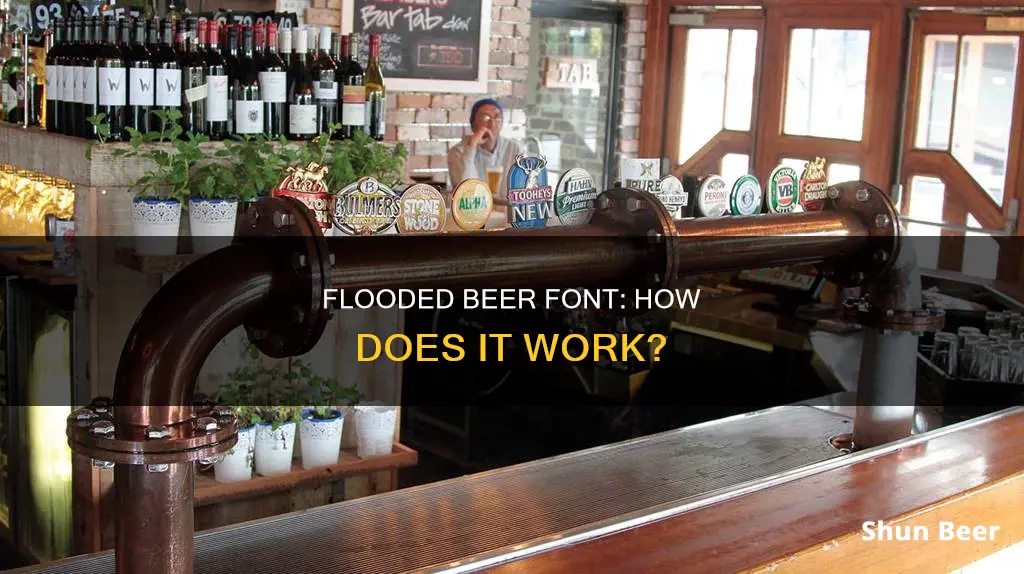
A flooded beer font is a system of flooding the font casing and lines with glycol. The cold temperature at the outer metal to air interface freezes the condensation on the font, making the outside of the font form ice. The glycol is constantly circulated through the font, glycol block, and python, with the glycol block acting as a cold reservoir to cool the drink and stabilize the system. The glycol mix is usually kept at a temperature of -2.5 to 4 degrees Celsius, which is lower than the freezing point of water, but above the freezing point of beer, which is usually around -2.5 degrees Celsius for a 5% beer. This system helps to ensure that beer is chilled right up to the dispensing point, preventing any hot spots in the dispensing system.
What You'll Learn

A glycol mix is used to cool the font and lines
The glycol mix used in these systems is typically propylene glycol, a non-toxic, food-grade antifreeze that has been used in food-processing systems for many years. It is important to use the right type of glycol, as some forms, like ethylene glycol, are extremely toxic and not suitable for food preparation. USP grade propylene glycol, on the other hand, has the approval of the United States Pharmacopeia, ensuring its quality and safety for use in food and beverage applications.
When preparing the glycol mix, it is crucial to use the proper ratio of glycol to water. A mix that is too glycol-rich can result in a freezing point far below what is necessary, wasting refrigerant. Conversely, a mix with insufficient glycol can cause the entire system to freeze, compromising the fermentation process. A traditional glycol mix of 35% is generally considered effective, providing a steady freezing point suitable for cold environments.
In a flooded beer font system, the glycol mix is pumped through the cooling lines that run parallel to the beer lines. This setup ensures that the beer remains chilled from keg to tap, delivering perfectly chilled beer to customers. Regular maintenance of the glycol dispensing system, including the power pack, trunk line, bath, hardware, and glycol itself, is essential to ensure proper cooling and maintain beer quality.
Beer Olympics: Competitive Drinking Games Explained
You may want to see also

The font casing is flooded with glycol
A glycol beer dispensing system is the latest in beer dispensing technology. A glycol system is an excellent alternative or upgrade from a traditional Temprite or Ice Bank beer system.
A glycol tank is placed in a refrigerated cool room. Using beer python, a minus-degree glycol is constantly circulated through the python, glycol block, font and back to the glycol tank. This results in a system where beverages are kept at a constant temperature from the keg to the beer tap, dramatically slowing the growth of wild yeast and bacteria in the beer lines and reducing beer wastage.
The flooded font was first introduced by Andale in the early 1990s. A flooded font is any form of font where glycol or water can flow through the inside of the font, cooling and stabilising the drink within the font. The glycol font helps to ensure that beer is chilled right up to the dispensing point, preventing any possible 'hot spots' in the dispensing system.
Glycol is an antifreeze agent that allows water to cool below zero degrees without freezing. Propylene glycol is non-toxic and is used exclusively in Andale's Glycol Block Beer Dispensing Systems. It is manufactured from propylene oxide and is used in foods, cosmetics and oral hygiene products as solvents, preservatives and moisture-retaining agents.
Glycol is a viscous, colourless and odourless synthetic liquid. It can absorb and release large amounts of heat while maintaining a consistent temperature. This unique ability makes it suitable for beverage chillers and other industrial refrigeration applications.
There are two main types of glycol: ethylene and propylene. Ethylene glycol is created by combining water with the chemical compound ethylene oxide. It is primarily used in industrial and manufacturing applications, such as coolant and antifreeze for automobiles and water systems. Propylene glycol, on the other hand, is a combination of water and propylene oxide. Its non-toxicity gives it a wide range of consumer product uses, including pharmaceuticals, food solvents and flavourings.
The Magic of Beer Randall: Infusing Beers with Flavors
You may want to see also

The cold temperature freezes condensation on the font
A flooded beer font is a form of font where glycol or water can flow through the inside of the font, cooling and stabilising the drink within the font. The cold temperature freezes condensation on the font, which forms from moisture in the air. The glycol flowing within the font has a lower freezing point than water, so the condensation freezes. This process cannot be guaranteed in a standard glycol system.
The temperature of the glycol is usually between 2 and -3.5 degrees Celsius. The colder temperature of the glycol is what allows it to freeze the condensation. This helps to ensure that the beer is chilled right up to the point of dispensing, preventing any possible "hot spots" in the dispensing system.
The formation of ice on the font is a great selling point for ice-cold tap beer. However, it is important to note that condensation on a chilled beverage is generally not a good sign as it can raise the temperature of the drink. This is because condensation is the opposite of evaporative cooling. When people sweat, the transition from liquid to gas has a cooling effect. However, when a cold beverage is in a humid environment, gaseous water condenses out of the air and clings to the beverage, transitioning from gas to liquid. This process expends energy in the form of heat, which is then absorbed by the beverage, warming it up. Therefore, the use of a koozie or insulated sleeve is recommended to keep condensation from forming.
Colorado EBT and Beer: What's the Deal?
You may want to see also

The font is designed to have glycol flow through it
A glycol beer dispensing system is the latest in beer dispensing technology. A glycol tank is placed in a refrigerated cool room. Using beer python, the glycol is constantly circulated through the python, glycol block, font, and back to the glycol tank. This results in a system where beverages are kept at a constant temperature from the keg to the beer tap, dramatically slowing the growth of wild yeast and bacteria in the beer lines and reducing beer wastage.
Glycol is an antifreeze agent that allows water to cool below zero degrees without freezing. Propylene glycol is non-toxic and is used exclusively in glycol block beer dispensing systems. It is manufactured from propylene oxide and is used in foods, cosmetics, and oral hygiene products as solvents, preservatives, and moisture-retaining agents.
The flooded font was first introduced by Andale in the early 1990s. A flooded font is any form of font where glycol or water can flow through the inside of the font, cooling and stabilizing the drink within the font. The glycol or water is pumped through the font to keep the beer chilled right up to the dispensing point, preventing any possible "hot spots" in the dispensing system.
The cold temperature of the outer metal to the air interface freezes the condensation on the font, forming ice on the outside of the font. This makes the flooded font an excellent option for keeping beer cold, as it ensures that the beer is dispensed at a constant temperature.
To clean a flooded font, it is necessary to remove the fittings at the bottom where the lines enter and carefully take out the o-ring and brass olive. By pushing the line in at the bottom, you can create enough slack to manoeuvre the white plastic bulkhead out of the font. There is another fitting at the back that needs to be removed, and then the line can be cut and pulled out. When installing new lines, it is important to slide the fitting over the new line, dip it in hot water, and press the collet in.
Beer as Petrol: Can You Really Run on Hops?
You may want to see also

The beer lines can be replaced
To replace the lines within a flooded font, you will need to start by removing the fittings at the bottom where the lines enter. Be cautious not to lose the small brass components that push the rubber seals up. Using an Allen key, unscrew the cap from the top and either end of the tee, allowing you to access the inside. Next, unscrew all the rings from the tap bulkheads. By pushing the line in at the bottom, you can create some slack to manoeuvre the white plastic bulkhead out of the font. There is another fitting at the back that needs to be addressed. You can cut the ends off the line and unscrew them, allowing you to pull the line back through the font.
Once the fittings are out of the bulkheads, you will find a small stainless collet inside the end of the line that needs to be reclaimed and placed in the new line. It is also recommended to soak the old font in a cleaning solution to remove any residual glycol. When installing the new line, ensure it protrudes about 8 inches out of each port in the font. Then, slide the fitting over the new line, dip it in hot water, and press the collet in. Finally, reverse the disassembly process to reassemble the font.
It is worth noting that there are variations in the design of flooded fonts, so the exact process may differ slightly. Additionally, it is always a good idea to consult a professional or seek further advice if you are unsure about any steps in the replacement process.
Beer Breakdown: Understanding Its Effect on the Human Body
You may want to see also
Frequently asked questions
A flooded beer font is a system of flooding the font casing and lines with glycol.
The cold temperature at the outer metal to air interface freezes the condensation on the font, making the outside of the font form ice.
The flooded font helps to ensure your beer is chilled right up to the dispensing point, preventing any possible ‘hot spots’ in your dispensing system.
You can take apart the font and remove the beer lines. It is recommended to soak the font in a cleaning solution to get all the old glycol out of it.
A pond or aquarium pump can be used to pump water or a glycol mix through a flooded beer font. The pump should have enough head to pump from the base of the freezer to the top of the font.







